Petrogenesis of Ultramafic Xenoliths from the 1800 Kaupulehu Flow ...
Petrogenesis of Ultramafic Xenoliths from the 1800 Kaupulehu Flow ...
Petrogenesis of Ultramafic Xenoliths from the 1800 Kaupulehu Flow ...
Create successful ePaper yourself
Turn your PDF publications into a flip-book with our unique Google optimized e-Paper software.
164 CHEN-HONG CHEN ET AL.olivine clinopyroxenite, with gabbro, troctolite, anorthosite, websterite, and two-pyroxenegabbro being much less common. Bohrson & Clague (1988) studied <strong>the</strong> petrography andmineral compositions <strong>of</strong> some <strong>of</strong> <strong>the</strong> ultramafic xenoliths containing exsolved pyroxenes.Our study complements <strong>the</strong>irs and concentrates on <strong>the</strong> abundant dunites, wehrlites, andohvine clinopyroxenites. With one exception, sample 68KAP1, <strong>the</strong> pyroxenes in <strong>the</strong> samples<strong>of</strong> <strong>the</strong>se rocks that we have studied do not show exsolution.In his pioneering study, White (1966) interpreted ultramafic xenoliths in Hawaiian alkalicbasalts to be cumulates <strong>from</strong> basaltic magma, but he did not specify whe<strong>the</strong>r <strong>the</strong> magmawas <strong>of</strong> Hawaiian or mid-ocean ridge origin. Dunite, wehrlite, and olivine clinopyroxenitexenoliths <strong>from</strong> Hawaiian alkalic basalts, including those <strong>from</strong> <strong>the</strong> <strong>1800</strong> <strong>Kaupulehu</strong> flow,were interpreted by Jackson (1968) as being partly cumulates and partly texturally deformedrestites <strong>from</strong> partial melting <strong>of</strong> upper-mantle peridotite. On <strong>the</strong> basis <strong>of</strong> a wide andrelatively iron-rich range <strong>of</strong> olivine compositions (Fo g3 _ 90 ), Sen & Presnall (1980, 1986)argued that dunite xenoliths <strong>from</strong> Koolau Volcano, Oahu, are samples <strong>of</strong> cumulates <strong>from</strong>Koolau tholeiites even though <strong>the</strong> dunite shows deformation textures. Jackson et al. (1981)reached a similar conclusion for deformed dunites <strong>from</strong> <strong>the</strong> <strong>1800</strong> <strong>Kaupulehu</strong> flow.However,<strong>the</strong> similarity <strong>of</strong> 3 He/*He values (8 x atmospheric) between Hualalai ultramafic xenolithsand mid-ocean ridge basalts (MORBs) led Kaneoka & Takaoka (1978, 1980), Kyser &Rison (1982), and Rison & Craig (1983) to conclude that <strong>the</strong>se xenoliths are fragments <strong>of</strong>MORB-type oceanic crust. Dunite and wehrlite xenoliths <strong>from</strong> Mauna Kea have beeninterpreted by Atwill & Garcia (1985) as deformed cumulates <strong>from</strong> Hawaiian alkalicmagmas. On <strong>the</strong> basis <strong>of</strong> spinel and clinopyroxene compositions, Clague (1988) concludedthat dunite and wehrlite xenoliths <strong>from</strong> Loihi Seamount were crystallized <strong>from</strong> Hawaiianalkalic magmas.To clarify <strong>the</strong> origin <strong>of</strong> <strong>the</strong> <strong>Kaupulehu</strong> ultramafic xenoliths, we have carried out a detailedmineralogical, isotopic, and geochemical study. The petrography and mineral compositions<strong>of</strong> 46 dunite, wehrlite, and olivine clinopyroxenite xenoliths have been studied. Eightxenoliths were selected for determination <strong>of</strong> trace element concentrations (REE, K, Rb, Ba,and Sr) and isotopic (Sr and Nd) compositions <strong>of</strong> separated clinopyroxenes.SAMPLE LOCATIONThe investigated samples were collected <strong>from</strong> <strong>the</strong> xenolith beds in olivine-bearing alkalicbasalt <strong>of</strong> <strong>the</strong> <strong>1800</strong> <strong>Kaupulehu</strong> flow on <strong>the</strong> north slope <strong>of</strong> Hualalai Volcano (Fig. 1). Twooutcrops <strong>of</strong> <strong>the</strong> uppermost layer <strong>of</strong> xenoliths were sampled, one located ~ 120 m nor<strong>the</strong>ast<strong>of</strong> <strong>the</strong> Hue Hue telephone repeater station and <strong>the</strong> o<strong>the</strong>r ~ 120 m sou<strong>the</strong>ast <strong>of</strong> this station(Jackson & Clague, 1981). Samples with <strong>the</strong> prefixes A, B, and X were collected by <strong>the</strong> firstauthor. The remainder were supplied by D. A. Clague and B. Melson <strong>from</strong> <strong>the</strong> collection <strong>of</strong><strong>the</strong> late E. D. Jackson, now housed at <strong>the</strong> Smithsonian Institution, Washington, DC.PETROGRAPHYThe xenoliths typically are subrounded, but some are angular. They have a meandiameter <strong>of</strong> ~ 7 cm (Jackson et a/., 1981). Most consist <strong>of</strong> varying proportions <strong>of</strong> olivine,spinel, and clinopyroxene; a few also contain small amounts <strong>of</strong> plagioclase and orthopyroxene(Table 1). Two main types <strong>of</strong> xenoliths have been identified, (1) dunite and (2) wehrliteand olivine clinopyroxenite (15-85% clinopyroxene). Several xenoliths are composites <strong>of</strong>dunite and wehrlite. Two generations <strong>of</strong> olivine crystals are evident even in hand samples,one comprising large dark crystals and <strong>the</strong> o<strong>the</strong>r made up <strong>of</strong> smaller and lighter re-
















